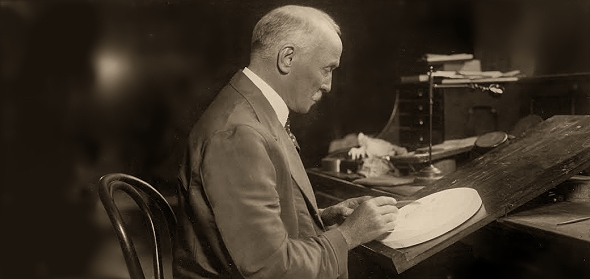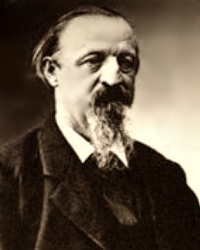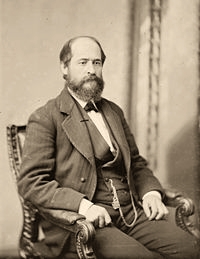By Shaquille Brissett of Gainesville Coins….
During the late 19th century, a culmination of market forces led to a volatility of the silver industry that provoked populist anxieties. Proposals by Representative Richard Bland and Iowa Senator William Allison would appease both Greenbackers (a post-civil war political party that favored the use of paper money and opposed the use of specie payments) and Silverites (a political party that believed silver should continue to be used as monetary standard), but force the treasury to mint millions of silver coins every month. George T. Morgan’s renowned Morgan Silver Dollar would prove to be a breath of fresh air for a mint being stifled by ballooning political pressures.

Nevertheless, Morgan’s time at the U.S. mint was one fraught with tension. Morgan’s introduction would foster animosity between himself and the mint’s chief engraver, William Barber, and his son, Charles. The Barbers felt Morgan’s inclusion might hinder Charles’ ascension to the position of chief engraver upon his father’s retirement.
The following will examine the profiles of these two men, their contentious relationship and how it connected to the development of one of the world’s most beloved coins, the Morgan Silver Dollar.

Foreseeing the implications of a Bland-Allison Act, Director of the U.S. Mint Dr. H.R. Linderman felt it best to begin cultivating a more aesthetically-pleasing coin. However, Linderman believed the chief engraver and his son were too incompetent to take on the task. This sentiment was shared by many of his contemporaries as evidenced by a letter from American sculptor Augustus Saint-Gaudens to President [Theodore] Roosevelt in which Saint-Gaudens states “[Barber] cannot possibly do an artistic work. He is a commercial medallist with neither the means nor the power to rise above such an average.”
It stands to reason that Barber was also known for taking the works of other engravers and using them for his own projects. As a result of his tepid faith in Barber, Linderman began to search for additional help at the mint. Director of the London Mint Charles W. Fremantle recommended George T. Morgan, a 30-year-old engraver from Birmingham, England. Morgan was a man whose proficiency in the art of engraving had garnered him the title of a man who has “made himself a considerable name.”
Morgan’s techniques developed from tutelage that juxtaposed the informal education of the Barbers. William Barber was taught primarily by his father, while Charles Barber was untrained at the time of his introduction to the Mint. Morgan’s studies took him from Birmingham School of Art, where he developed his sculpting and modeling practices, to South Kensington Art School and eventually to an apprenticeship under Messrs. J.S. & A.B. Wyon at the British Royal Mint. One might assume that it is his formal instruction that culminated in Morgan’s favoritism at the Mint. The warm reception to Morgan’s introduction permeated throughout the Mint, however he was not completely without combatants.
Morgan’s potential to become chief engraver was capable of disrupting the time-honored tradition of sons succeeding their father. Because of his perceived intrusion, Morgan became embroiled in a tense and adversarial relationship with the Barbers.

Shortly after his arrival to the mint, Morgan was told that there was no available space for him in the mint building. (It should be noted that the Barbers used their room not only for work but also to conduct private business, essentially squandering taxpayer money). Moreover, Morgan was forced to work in a private room away from Mint grounds. Morgan would continue to operate out of this rooming house until Linderman intervened, forcing Barber to make space for Morgan at the Mint. This event, however, is only one of the first instances in which Barber’s tactics would prove an impediment for Morgan. During the spring and summer of 1877, Morgan would often use the old screw press to produce patterns for gold and silver coins. William Barber subsequently ordered Morgan not to use the machine without express approval from the superintendent. Once again, it took the intervention of Linderman to remove this arbitrary ruling. One might surmise that Linderman’s preference for Morgan was an unintended consequence of this type of protectionism. Nevertheless, Superintendent James Pollock was appointed to ensure that works produced by the machine were being properly manufactured.
In 1878, an assignment from Linderman would further catalyze their rivalry. After a tumultuous debate and a circumvention of a presidential veto, the Bland-Allison Act was passed, requiring the Treasury to purchase several million dollars worth of silver to be minted as silver dollars every month. The bill was meant to help an ailing silver industry that had fallen victim to declining prices. A few months prior to the bill’s passing, Linderman predicted the public’s desire for a new silver dollar design and assigned Morgan the task of remaking an earlier half dollar design into a dollar format. Barber was assigned a similar task, with one exception: Barber was told to complete the task using new devices rather than existing ones.
William Barber was undoubtedly at a competitive disadvantage.
By December, both parties had presented patterns struck from master dies. Superintendent Pollock noted that Morgan’s patterns were created by graceful yet skilled hands while Barber offered a rather poor presentation, probably as a result of rushing. Barber’s patterns were later restruck using copper rather than silver so that his designs would be visible. Both the designs of Morgan and Barber were well-received amongst members of the Treasury. In a private correspondence to Pollock, Dr. Linderman revealed that Barber’s patterns had “gone off like hotcakes.” However, Linderman subsequently conceded that Morgan’s patterns were still more popular. Throughout the coming days, both parties would continue to refine and improve their patterns, but Barber made attempts to thwart Morgan’s productivity by restricting Morgan’s access to the Hill reducing machine. An angered Linderman removed the restriction and counted this incident as the second strike against Barber.

By February 28th, it had come time to choose a design for the silver dollars commissioned by the newly enacted Bland-Allison Act. Morgan’s designs were cultivated with the assistance of Philadelphia Postmaster A.L. Snowden and Linderman, while Barber had been left to fend for himself. Morgan’s design featured educator Anna Willess Williams as the Lady Liberty, and negated the classical design in favor of a more American one. Fitting snugly in Lady Liberty’s crown are ears of wheat and cotton, two symbols which testify to the blossoming of the American economy. Lady Liberty also dons a Phrygian cap, an ancient symbol of freedom. The coin’s reverse features an eagle with outstretched wings and both olive branches and arrows clenched in its talons. These symbols represent America’s leanings toward peace but its readiness for war.
As expected, it was Morgan’s patterns that were chosen; however, it has been theorized that Linderman had a hand in swaying the Secretary of the Treasury John Sherman’s decision. Nonetheless, Charles Barber did succeed his father, but it would be erroneous to claim that he had a more successful career than his rival. On the contrary, the Barber era seemed to facilitate a demand for outside artists. For example, over the following years sculptors from outside the Mint such as Augustus Saint-Gaudens, James Earle Fraser, A.A. Weinman, Bela Lyon Pratt and Victor Brennan would all be chosen over mint employees to design patterns for commissioned coins.
For his lack of technical and artistic merit, we can ironically thank Charles Barber for this change in tradition at the Mint. And as collectors, we must appreciate the external forces which culminated in the creation of the Morgan dollar, arguably America’s favorite coin.





Awesome article